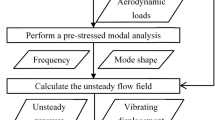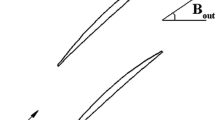Abstract
With the development of the load level of the multistage axial compressor, the interaction among different rotors, which usually keeps at high intensity and significantly influences the compressor performance, should not be ignored during the compressor design. The research aims to reveal the mechanisms of an interaction phenomenon between R1 (the first rotor) and R2 (the second rotor) in which the blade sweep characteristics are influenced by multiple factors such as the shock wave and wake flow effects. Unlike the traditional explanation, the results present the essence of a special R1-2BPF (the second harmonic of the blade passing frequency of R1) disturbance originating from R1 which is different from the commonly-recognized harmonic of blade wake effect and generated by the interaction between the oblique shock wave at R1 leading-edge and the pressure rise region after the passage shock wave. It is the coupling effect of this structure, wake separation region of R1 and S1, and the suction-side flow separation of R2 that determines the propagation of R1-1BPF (the first harmonic of the blade passing frequency of R1) and R1-2BPF disturbances inside the rotor passages. Moreover, under the additional impacts of the R2 hub slope and centrifugal force, it is noticed that the strengths of the R1-1BPF and R1-2BPF disturbances suddenly increase at some specific locations. All the results will provide more theories to the optimization of highly loaded compressor.




















Similar content being viewed by others
Data Availability
All data, models, and code generated or used during the study appear in the submitted article.
Abbreviations
- BPF:
-
blade passing frequency
- c r :
-
the radial velocity
- c u :
-
the circumferential velocity
- f r :
-
the radial force in source term
- LE:
-
leading edge
- p rot2 :
-
pressure rise within R2
- ps :
-
pressure rise from inlet
- p ′ :
-
the assemble-average pressure distrubance at specific phase
- \(\overset{\sim }{\mathrm{p}}\) :
-
pressure coefficient
- R1:
-
the first rotor
- R1-1BPF:
-
the disturbance of R1 at blade passing frequency
- R1-2BPF:
-
the disturbance of R1 at the second harmonic of blade passing frequency
- R2:
-
the second rotor
- S1:
-
the first stator
- TE:
-
trailing edge
- u tip :
-
tip tangential speed of R1
- ρ:
-
the density of air
References
Smith LH (1993) Wake ingestion propulsion benefit. AIAA Journal of Propulsion and Power 9(1):74–82
Van Zante DE, Adamczyk JJ, Strazisar AJ (2002) Wake recovery performance benefit in a high-speed axial compressor. ASME Journal of Turbomachinery 124:275–284
Van der wall AG, Kadambi JR, Adamczyk IJ (2000) A transport model for the deterministic stresses associated with turbomachinery blade row interactions. ASME Journal of Turbomachinery 122:593–603
Ottavy X, Trebinjac I, Vouillarmet A (2001) Analysis of the interrow flow field within a transonic axial compressor: Part 1-Experimental invesitgation. ASME Journal of Turbomachinery 123:49–56
Ottavy X, Trebinjac I, Vouillarmet A (2001) Analysis of the interrow flow field within a transonic axial compressor: Part 2-Unsteady flow analysis. ASME Journal of Turbomachinery 123:57–63
Lecheler S, Schnell R, Stubert B (2001) Experimental and numerical investigation of the flow in a 5-stage transonic compressor rig. In: ASME IGTI Conference. Paper No.2001–0344
Gorrell SE, Okiishi TH, Copenhaver WW (2003) Stator-Rotor interactions in a transonic compressor-Part 1:Effect of blade-row spacing on performance. ASME Journal of Turbomachinery 125:328–335
Gorrell SE, Okiishi TH, Copenhaver WW (2003) Stator-Rotor interactions in a transonic compressor-Part 2:Description of a loss-producing mechanism. ASME Journal of Turbomachinery 125:336–345
Mailach R, Vogeler K (2003) Aerodynamic blade row interaction in an axial compressor. Part 1-Unsteady boundary layer development. In: ASME IGTI Conference. Paper No.2003–38765
Mailach R, Lehmann I, Vogeler K (2008) Periodical unsteady flow within a rotor blade row of an axial compressor-part 1: flow field at midspan. ASME Journal of Turbomachinery 130:041004
Mailach R, Lehmann I, Vogeler K (2008) Periodical unsteady flow within a rotor blade row of an axial compressor-part 2: wake-tip clearance vortex interaction. ASME Journal of Turbomachinery. 130:041005
Wheeler APS, Miller RJ (2008) Compressor wake/leading-edge interactions at off-design incidences. In: ASME IGTI Conference. Paper No.2008–50177
Wheeler APS, Sofia A, Miller RJ (2007) The effect of leading-edge geometry on wake interactions in compressors. In: ASME IGTI Conference. Paper No.2007–27802
Yamagami M, Kodama H, Kato D (2009) Unsteady flow effects in a high-speed multistage axial compressor. In: ASME IGTI Conference. Paper No.2009–59583
Hah C (2015) Effects of unsteady flow interactions on the performance of a highly-loaded transonic compressor stage. In: ASME IGTI Conference. GT-2015-43389
Zhao JY, Wang ZH, Zhao Y (2018) Investigation of transient flow characteristics inside a centrifugal compressor for design and off-design conditions. Proceedings of the Institution of Mechanical Engineers: Part A-Power and Energy 232(4):364–385
Zhao HJ, Wang ZH (2017) Unsteady flow structures in the tip region for a centrifugal compressor impeller before the rotating stall. Sci China Technol Sci 60(6):924–934
Jia HX, Xi G, Müller L (2010) Unsteady blade loading with clocking in multistage axial compressors, part 1. AIAA Journal of Propulsion and Power 26:25–35
Stading J, Friedrichs J, Waitz T (2012) The potential of rotor and stator clocking in a 2.5-stage low-speed axial compressor. In: ASME IGTI Conference. Paper No.2012–68353
Florian F, Vogt DM, Bladh R (2013) Unsteady forcing vs. efficiency-the effect of clocking on a transonic industrial compressor. In: ASME FEDSM Conference, Paper No.FEDSM2013–16583
Hsu ST, Wo AM (1998) Reduction of unsteady blade loading by beneficial use of vertical and potential disturbances in an axial compressor with rotor clocking. ASME Journal of Turbomachinery 120:705–713
He L, Chen T, Wells RG (2002) Analysis of rotor-rotor and stator-stator interferences in multi-stage turbomachines. ASME Journal of Turbomachinery 124:564–571
Mileshin V, Druzhinin Y, Stepanov A (2015) Numerical and experimental investigations of clocking effect in a two-stage compressor with πc = 3.7. ASME IGTI Conference. Paper No.2015–43472
Ernst M, Michel A, Jeschke P (2011) Analysis of rotor-stator-interaction and blade-to-blade measurements in a two stage axial flow compressor. ASME Journal of Turbomachinery 133:011027
Xiang HH, Jiang SQ, Gao J (2018) Experimental investigation of rotor tip clearance flow instability in transonic axial flow compressor. Gas Turbine Exp Res 31(3):5–13 (in Chinese)
Spalart P, Allmaras S (1992) A one-equation turbulence model for aerodynamic flows. In: AIAA 30th Aerospace Sciences Meeting and Exhibit
Zhao Y, Xi G, Wang ZH (2020) Numerical investigation of deep surge in a centrifugal compressor with vaned diffuser and large plenum. Proceedings of the Institution of Mechanical Engineers: Part A-Power and Energy 234(2):143–155
Zhao JY, Xi G, Wang ZH (2018) Investigation of the spike-stall warning method using the blade passing signal. Sci China Technol Sci 61(6):44–56
Acknowledgements
The authors would like to gratefully acknowledge the support of National Natural Science Foundation of China (No. 52130603 and 11732016).
Author information
Authors and Affiliations
Corresponding author
Ethics declarations
Conflict of Interest
The authors declare that they have no competing interest.
Additional information
Publisher’s Note
Springer Nature remains neutral with regard to jurisdictional claims in published maps and institutional affiliations.
Rights and permissions
About this article
Cite this article
Zhao, J., Lu, Q., Yang, D. et al. The Mechanism Analysis of Rotor/Rotor Interference Phenomenon within the Multistage Transonic Compressor. Exp Tech 47, 295–312 (2023). https://doi.org/10.1007/s40799-022-00545-w
Received:
Accepted:
Published:
Issue Date:
DOI: https://doi.org/10.1007/s40799-022-00545-w




